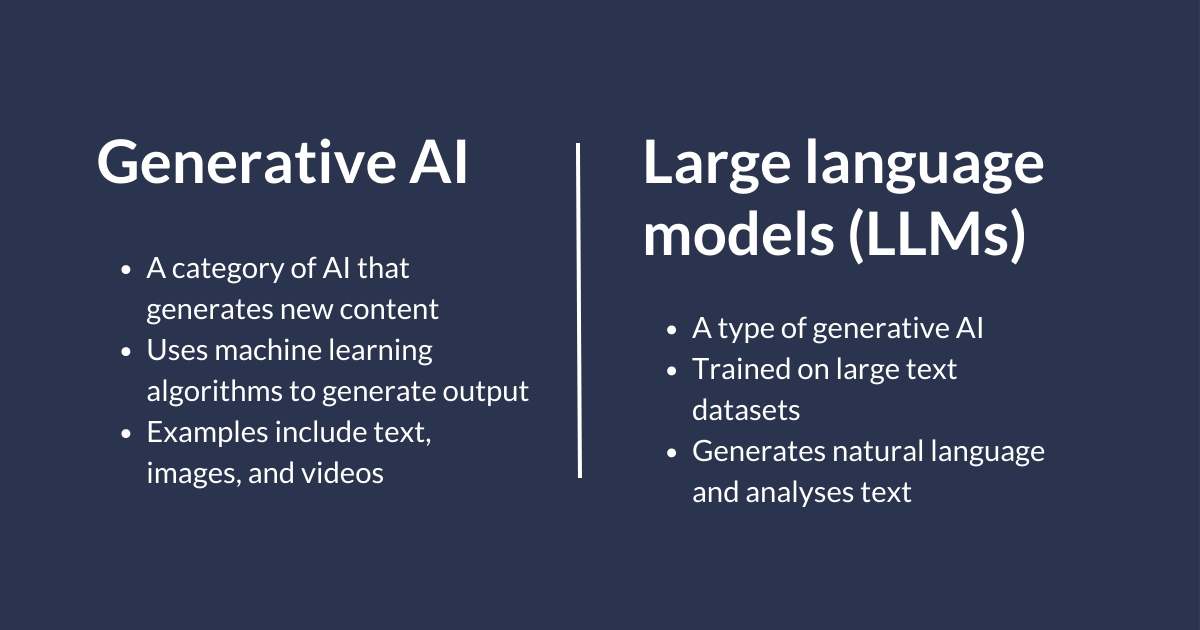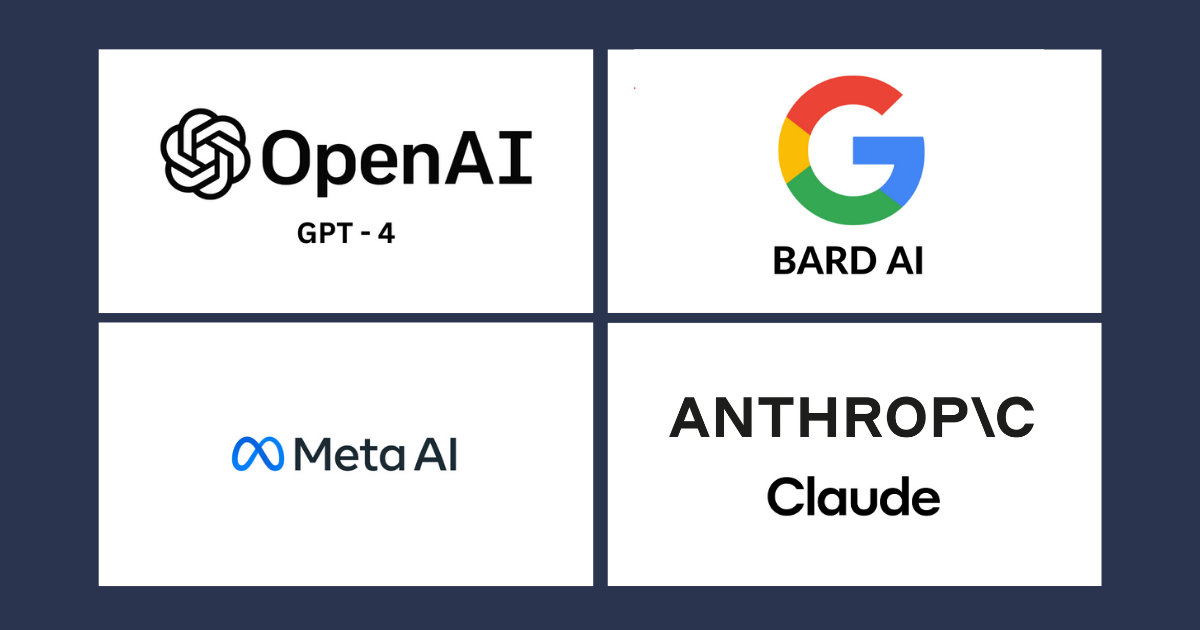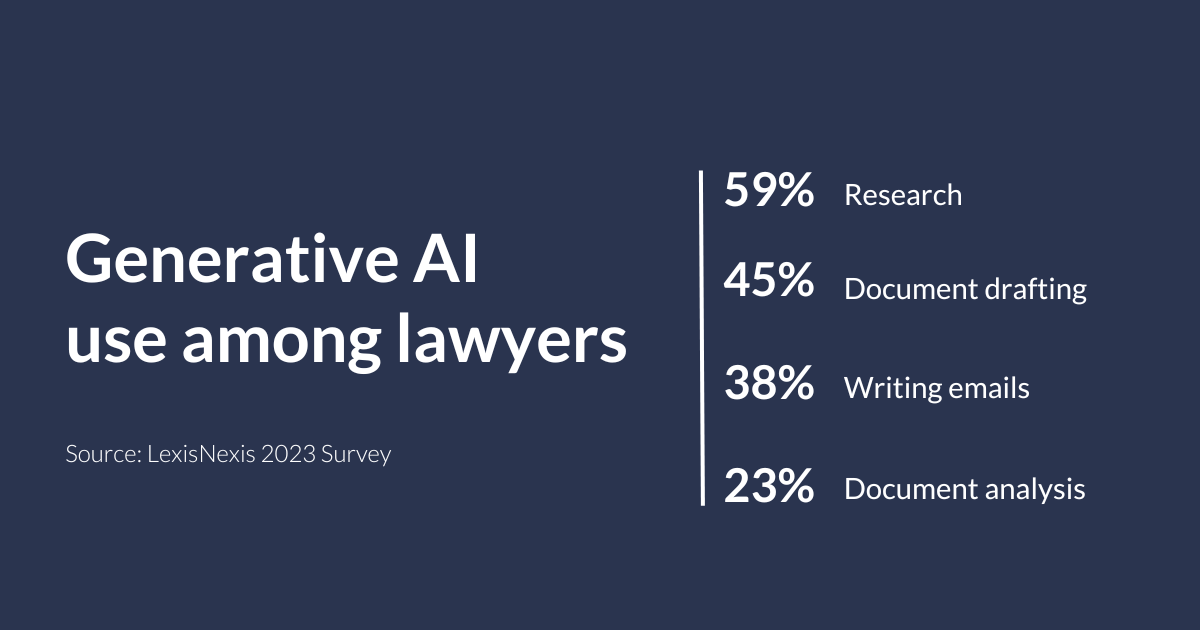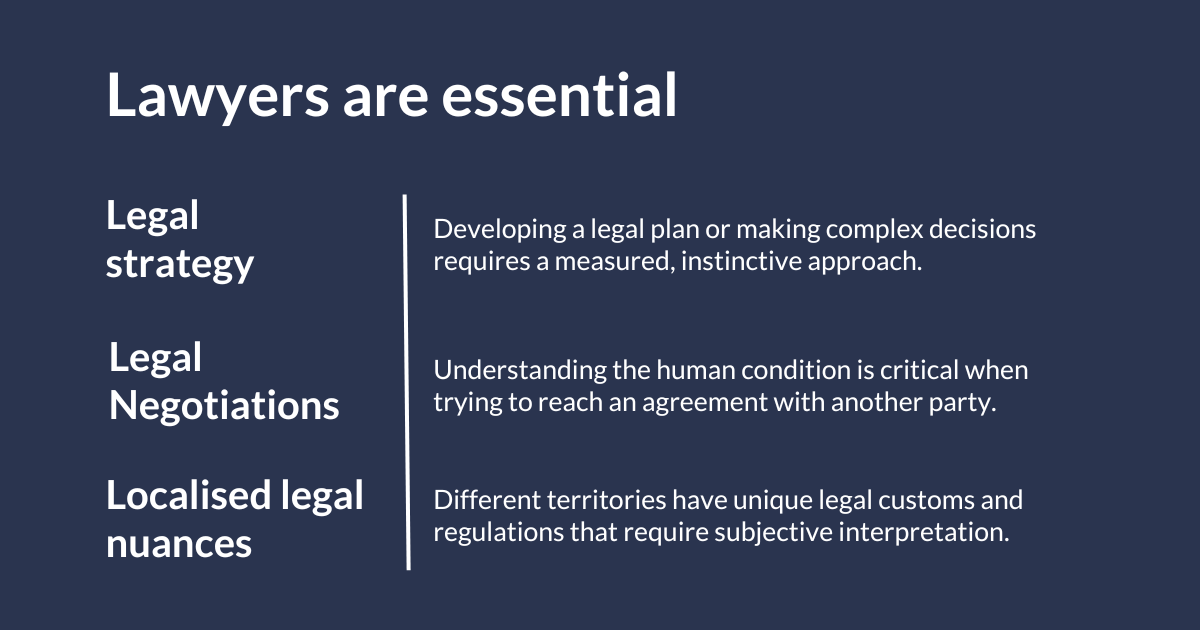Generative AI in Legal: Overviews, Obstacles and Opportunities
July 4, 2023

Overviews
Ever since ChatGPT burst onto the scene back in November 2022 and reached an astonishing 100 million users in just two months, generative AI has permeated popular culture, mainstream news, social media and the world of work in ways few of us have ever seen.
For those who may still be unfamiliar, generative AI refers to a broad category of AI that is able to generate new content, including text, images, videos and more. There’s also large language models (LLMs), a specific type of generative AI that’s trained on huge text datasets to generate new natural language and analyse text.

Whilst LLMs have been around for a few years, the recent explosion of interest in them stems from a new generation of models which have hundreds of billions of parameters, trained on many terabytes of text data from all over the internet.
In the hands of a curious general public simply testing the limits of their imagination, generative AI has produced some bizarre results and a variety of social media pages dedicated to highlighting all the weird and wonderful things that users want to create.
However, when applied in the right context with targeted prompts from subject matter experts trying to complete a specific task, there’s no question that this technology’s effectiveness is quickly improving with every iteration.
Comparing large language models
As such, we’re seeing more sophisticated and exciting generative AI tools and LLMs getting widespread recognition, such as:
- GPT-4 (OpenAI): Trained on hundreds of billions of parameters, the latest addition to the “GPT-n” series can generate paragraphs of text, answer questions, translate between languages, and more.
- Bard (Google): Powered by Google's most advanced LLM PaLM 2, Bard is an experimental AI chat service that can code, answer questions and help with writing.
- Language Large Models Meta AI/LLaMA (Meta): LLaMA can be used in generating text, having conversations, summarising written material and more complicated tasks like solving math theorems or predicting protein structures.
- “Claude” (Anthropic): An AI-assistant developed by Anthropic using a technique called Constitutional AI to align language models with natural language feedback. It can generate human-like text while being helpful, harmless and honest.

Given this is emerging technology with considerable yet still largely undiscovered potential, there is understandably some trepidation and ethical concerns. However, companies like Anthropic are working tirelessly to ensure AI is as safe as possible, and the UK government has recently launched an AI Taskforce to assess the risks and opportunities associated with generative AI.
At the same time, though, there’s also an inarguable sense of curiosity and huge optimism about how generative AI is going to revolutionise every aspect of traditional knowledge work.
Large language models in the legal industry
This is particularly true of the legal industry, who are understandably sceptical of new technology and slow to adopt it given the high standards that legal work demands. Yet, many legal teams are exploring how generative AI can help them and an increasing number are already using it to aid with their day-to-day operations.
In fact, an April 2023 LexisNexis survey entitled Generative AI & the Legal Profession discovered that 19% of the 1,176 lawyers they spoke to have already used generative AI in their work. Some of the tasks that it’s being used for include researching matters (59%), drafting documents (45%), writing emails (38%) and document analysis (23%).

Given their somewhat technophobic reputation, the fact that nearly one in five lawyers have found a practical application for generative AI, even though we’ve still got so much to discover about it, speaks volumes about the perception of it’s potential.
Ultimately though, there’s still a lot to discover about generative AI, and a key takeaway from the LexisNexis survey is that the general feeling from respondents surrounding its promise is simply “wait and see”.
With this in mind, it’s important that all the aspects of generative AI’s perceived and present attributes are addressed, in order for legal teams to possess the required clarity on where they might apply it to their work both now and in the future.
Obstacles
Given the palpable hype and extensive media coverage surrounding generative AI, there’s a section of lawyers who have understandably got carried away with notions of a future where “robot lawyers” take over and humans are no longer relevant to the practice of law.
However, this absolutely isn’t the case, and to ensure firms don’t take their legal tech strategy in the wrong direction due to false promises or lofty expectations, it’s crucial to establish the current limitations of generative AI in the legal space.
Firstly, to understand why such limitations exist, consider the importance of humans in both the application of technology and the practice of law.
Humans are key in AI development
Humans are essential to inform the way technology is used, developed and integrated in any scenario, and the legal space is no different.
No matter how much data it’s been trained on, in order for generative AI to produce the ideal output to help legal teams with their day-to-day, it still depends on lawyers to enter prompts targeted at the specific areas of legal work where they require help.
Lawyers play a vital role in AI implementation
At the same time, generative AI doesn’t yet have the capacity to apply fundamentally human characteristics such as social awareness and emotional intelligence to its work, which are imperative traits for those practicing law.
Therefore, in several instances across typical legal work, there’s no substitute for what the human mind and years of experience brings to the table.
Areas where lawyers are necessary
1. Legal strategy
Take developing a legal strategy or making a complex decision, for example. Generative AI might excel at high-volume, repetitive tasks, but it isn’t suited to problem-solving on the fly when faced with a difficult decision or defining a strategy. This is because these tasks ultimately require a measured, instinctive approach that can’t necessarily be taught via machine learning.
2. Human empathy in negotiations
The same can be said for negotiating and the role that empathy and a distinct understanding of the human condition plays when trying to reach an agreement with another party. There are early-stage attempts to develop empathic AI out there, which is already a huge leap forward, though may take a little longer to fully develop, as it’s unlikely that AI will face the collective struggle that’s enabled humans to evolve their emotional intelligence across millennia.
3. Localised legal nuances
Different jurisdictions, particularly ones that are highly-localised, are littered with various legal nuances related to local customs and regulations that require subjective interpretation. Whilst generative AI can be trained to understand established legal precedents, it takes them at face value and won’t realise that different localities might apply alternative approaches on a case-by-case basis.
So it’s not necessarily that AI isn’t equipped to handle these instances, because fundamentally it understands the law, there’s just certain applications of it that require an experienced lawyer to be in the loop, who is well-versed on how different territories operate and the practical intricacies of their approach to local law.

Though the current limitations of generative AI appear to support the arguments of lawyers who feel it won’t have any lasting impact on the legal profession, this has very little bearing as they’re actually tied to areas of high-value legal work that the LexisNexis survey found lawyers typically view as having less potential to help them at the current time.
All these limitations actually do is highlight that there’s no substitute for humans in the places that they’re most effective, however when it comes to time-consuming, repetitive, lower-value legal work, the scope for game-changing applications of generative AI is considerable.
Opportunities

When it comes to what generative AI can do for legal teams, the key thing to understand is that AI isn’t designed to replace the lawyer, but to augment their efficiency and productivity.
This means leaning into the things that generative AI does best, which as it turns out, are exactly the type of tasks that hold humans back from doing what they do best. Bringing humans and AI together means we can get the best of both worlds, where lawyers and AI apply their respective skills to the areas where they truly excel.
Focus on high value strategy
So much of a lawyer’s typical day-to-day work revolves around time-consuming manual analysis of lengthy legal documents that can take hours, if not days, to get through. With the correct training from legal and machine learning experts, generative AI is able to do this in seconds, combing through dozens of pages of text to draw out important information and present a summary of key points and provisions in a simple, user-friendly fashion. This mitigates risks associated with human error and allows legal teams to pour more of their focus into higher-value activities like strategy.
Fine-tune generative AI for legal use
However, it’s important to make the distinction between using generative AI as an add-on to existing technology and fine-tuning it to be built for a specific legal use case. Simply adding a ChatGPT-style feature to a legacy legal tech system that’s not AI-native means that it’ll be fundamentally limited to what it can offer users. At Robin AI, we harness the power of our partner Anthropic’s LLM, which we have configured to seamlessly work alongside our AI-native modular contract software to ensure that its many applications are best suited to supporting legal teams.
Equally, it’s worth noting that some generative AI tools like ChatGPT have smaller context windows, meaning they’re limited by the amount of text they can consume at any one time. Alongside their safety and reliability-focused approach to generative AI, another key benefit of our partnership with Anthropic is that Claude’s context window enables our software to analyse around 150 pages of text almost instantly, meaning it can easily handle the lengthiest contracts. So even though generative AI is exceptionally good at absorbing and summarising text, which undoubtedly saves hundreds of hours of manual legal work, it still requires lawyers to ensure the tools they’re using are designed for the legal use case in order for it to be most effective.
Streamline contract analysis
These capabilities also enable generative AI to be a really useful tool when it comes to identifying particular clauses in a contract and more broadly, to provide reliable answers to questions that legal teams need addressing. Our generative AI-powered contract copilot, Robin, is a prime example of where generative AI’s conversational nature excels at helping lawyers drill-down into forensic details to inform their higher-value work.
A user can ask Robin particular questions about their contracts, such as “does this contract automatically renew?” or “what are the customer’s rights in this contract?” and get instantaneous responses. This is ideal for lawyers who have a specific task to complete, yet don’t want to spend hours on end having to search for a clause or set of clauses that contain the information they need. Robin will read the contract, locate the text that matches what the user is looking for and bring it into the chat feature in the most concise way possible, all in a matter of moments.
Speed up contract drafting
Of course, the biggest clue to a key application of generative AI lies within the name: generation. Thanks to LLMs and natural language processing abilities, generative AI is fundamentally suited to mimicking the way humans write and speak. For legal teams, this means they have a helping hand when it comes to drafting the various text-focused work related to contracts.
This can be for any number of things. For instance, our users can ask Robin to draft an exclusivity clause, an email to a CEO summarising key terms in a contract, or even translate clauses into different languages. Not only do legal teams benefit from instant turnaround, but they’re never having to start from scratch, as Robin provides them with a fully-written draft to build on. This isn’t to say that the writing is always perfect, but with a clear structure in place and all the relevant information present, legal teams can expedite this typically time-consuming process.
Optimise contract review
Generative AI isn’t just a writer, it’s an editor too, and when it comes to reviewing contracts received from counterparties, is the perfect companion to help you be consistent with negotiating positions and contract language. Our legal team works closely with organisations to establish a bespoke playbook of preferred language and negotiation positions, which is then fed into our machine learning models so that Robin can provide users with the advice they require when it comes to contract review.
The essential function of this is to minimise redline, which of course is a major blocker for any legal team trying to get a contract through the negotiation process in a timely manner. With automated precision editing, Robin suggests edits to clauses based on pre-approved language and brings this to the user’s attention, where they have the choice whether to accept the suggested edits or not.
Given that generative AI is still relatively new technology, there’s rightfully a great deal of anticipation about what’s on the horizon, with tremendous scope for these attributes to grow considerably and exciting new applications to appear as it develops, all with the possibility of revolutionising day-to-day legal work.
Summary
With this technology constantly evolving and updates seemingly every day around new functionality and applications in the generative AI space, it can be difficult to maintain complete awareness of what’s happening.
For lawyers who want to be prepared for the future, first-hand experience with using generative AI is essential, because there’s no better way to understand its capabilities and limitations than taking the time to try and test it out for yourself.
This is why at Robin AI, we offer free versions of our modular contract platform so that legal teams can see for themselves the various benefits that using generative AI can bring to their typical working day.
Our goal is to ensure that generative AI is used safely and responsibly, which is exactly why we want lawyers to test our technology rather than just telling them about it. We know that generative AI can be a trusted and highly-effective tool that will truly make a difference to legal teams both today and in the future, but we also appreciate that lawyers need assurances that this technology is as safe and risk-averse as possible.
So be cautious. Be optimistic. Generative AI is new and exciting, but there’s still so much to discover and without a doubt, a lot more groundbreaking things to come. Legal teams have to approach generative AI like they approach their work, by being measured and strategic, not just jumping on the latest technological trend. They need to really understand the legal use cases of generative AI, work out what fits and where it fits, but also where it doesn’t yet.
The generative AI train has barely left the station but it isn’t stopping anytime soon, so join us on this exciting journey towards the future of day-to-day legal work.
Create your free account with Robin AI and harness the power of generative AI for legal.

